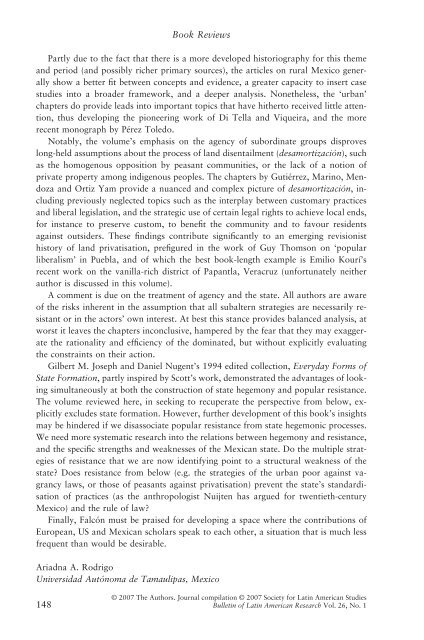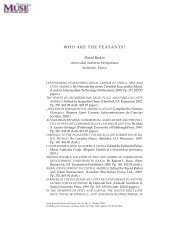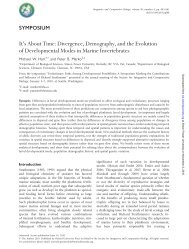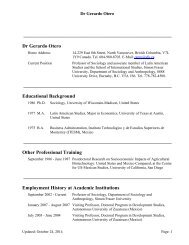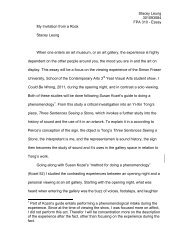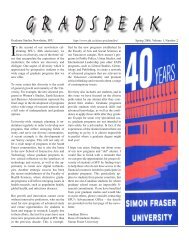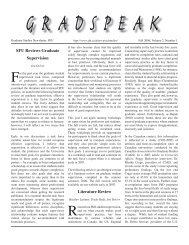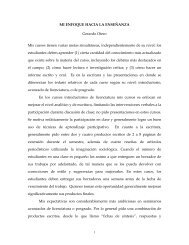Review of Mexico in Transition by Byron Crites
Review of Mexico in Transition by Byron Crites
Review of Mexico in Transition by Byron Crites
- TAGS
- transition
- byron
- crites
- cgi.sfu.ca
You also want an ePaper? Increase the reach of your titles
YUMPU automatically turns print PDFs into web optimized ePapers that Google loves.
Book <strong>Review</strong>s<br />
Partly due to the fact that there is a more developed historiography for this theme<br />
and period (and possibly richer primary sources), the articles on rural <strong>Mexico</strong> generally<br />
show a better fi t between concepts and evidence, a greater capacity to <strong>in</strong>sert case<br />
studies <strong>in</strong>to a broader framework, and a deeper analysis. Nonetheless, the ‘ urban ’<br />
chapters do provide leads <strong>in</strong>to important topics that have hitherto received little attention,<br />
thus develop<strong>in</strong>g the pioneer<strong>in</strong>g work <strong>of</strong> Di Tella and Viqueira, and the more<br />
recent monograph <strong>by</strong> Pérez Toledo.<br />
Notably, the volume ’ s emphasis on the agency <strong>of</strong> subord<strong>in</strong>ate groups disproves<br />
long-held assumptions about the process <strong>of</strong> land disentailment ( desamortización ), such<br />
as the homogenous opposition <strong>by</strong> peasant communities, or the lack <strong>of</strong> a notion <strong>of</strong><br />
private property among <strong>in</strong>digenous peoples. The chapters <strong>by</strong> Gutiérrez, Mar<strong>in</strong>o, Mendoza<br />
and Ortiz Yam provide a nuanced and complex picture <strong>of</strong> desamortización , <strong>in</strong>clud<strong>in</strong>g<br />
previously neglected topics such as the <strong>in</strong>terplay between customary practices<br />
and liberal legislation, and the strategic use <strong>of</strong> certa<strong>in</strong> legal rights to achieve local ends,<br />
for <strong>in</strong>stance to preserve custom, to benefi t the community and to favour residents<br />
aga<strong>in</strong>st outsiders. These fi nd<strong>in</strong>gs contribute signifi cantly to an emerg<strong>in</strong>g revisionist<br />
history <strong>of</strong> land privatisation, prefi gured <strong>in</strong> the work <strong>of</strong> Guy Thomson on ‘ popular<br />
liberalism ’ <strong>in</strong> Puebla, and <strong>of</strong> which the best book-length example is Emilio Kourí ’ s<br />
recent work on the vanilla-rich district <strong>of</strong> Papantla, Veracruz (unfortunately neither<br />
author is discussed <strong>in</strong> this volume).<br />
A comment is due on the treatment <strong>of</strong> agency and the state. All authors are aware<br />
<strong>of</strong> the risks <strong>in</strong>herent <strong>in</strong> the assumption that all subaltern strategies are necessarily resistant<br />
or <strong>in</strong> the actors ’ own <strong>in</strong>terest. At best this stance provides balanced analysis, at<br />
worst it leaves the chapters <strong>in</strong>conclusive, hampered <strong>by</strong> the fear that they may exaggerate<br />
the rationality and effi ciency <strong>of</strong> the dom<strong>in</strong>ated, but without explicitly evaluat<strong>in</strong>g<br />
the constra<strong>in</strong>ts on their action.<br />
Gilbert M. Joseph and Daniel Nugent ’ s 1994 edited collection, Everyday Forms <strong>of</strong><br />
State Formation , partly <strong>in</strong>spired <strong>by</strong> Scott ’ s work, demonstrated the advantages <strong>of</strong> look<strong>in</strong>g<br />
simultaneously at both the construction <strong>of</strong> state hegemony and popular resistance.<br />
The volume reviewed here, <strong>in</strong> seek<strong>in</strong>g to recuperate the perspective from below, explicitly<br />
excludes state formation. However, further development <strong>of</strong> this book ’ s <strong>in</strong>sights<br />
may be h<strong>in</strong>dered if we disassociate popular resistance from state hegemonic processes.<br />
We need more systematic research <strong>in</strong>to the relations between hegemony and resistance,<br />
and the specifi c strengths and weaknesses <strong>of</strong> the Mexican state. Do the multiple strategies<br />
<strong>of</strong> resistance that we are now identify<strong>in</strong>g po<strong>in</strong>t to a structural weakness <strong>of</strong> the<br />
state? Does resistance from below (e.g. the strategies <strong>of</strong> the urban poor aga<strong>in</strong>st vagrancy<br />
laws, or those <strong>of</strong> peasants aga<strong>in</strong>st privatisation) prevent the state ’ s standardisation<br />
<strong>of</strong> practices (as the anthropologist Nuijten has argued for twentieth-century<br />
<strong>Mexico</strong>) and the rule <strong>of</strong> law?<br />
F<strong>in</strong>ally, Falcón must be praised for develop<strong>in</strong>g a space where the contributions <strong>of</strong><br />
European, US and Mexican scholars speak to each other, a situation that is much less<br />
frequent than would be desirable.<br />
Ariadna A . Rodrigo<br />
Universidad Autónoma de Tamaulipas, <strong>Mexico</strong><br />
© 2007 The Authors. Journal compilation © 2007 Society for Lat<strong>in</strong> American Studies<br />
148 Bullet<strong>in</strong> <strong>of</strong> Lat<strong>in</strong> American Research Vol. 26, No. 1


